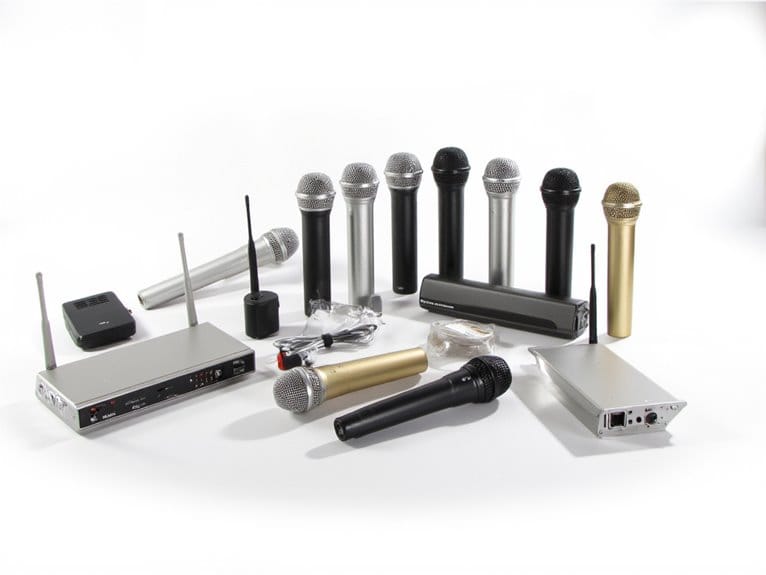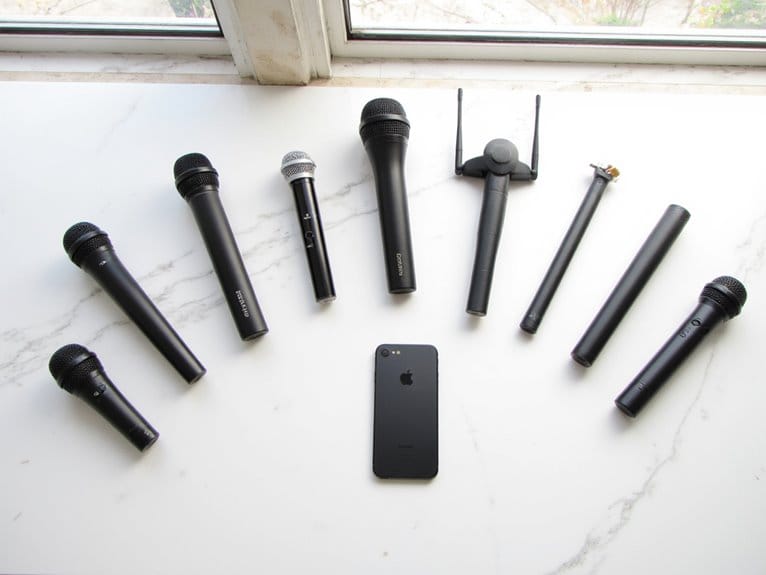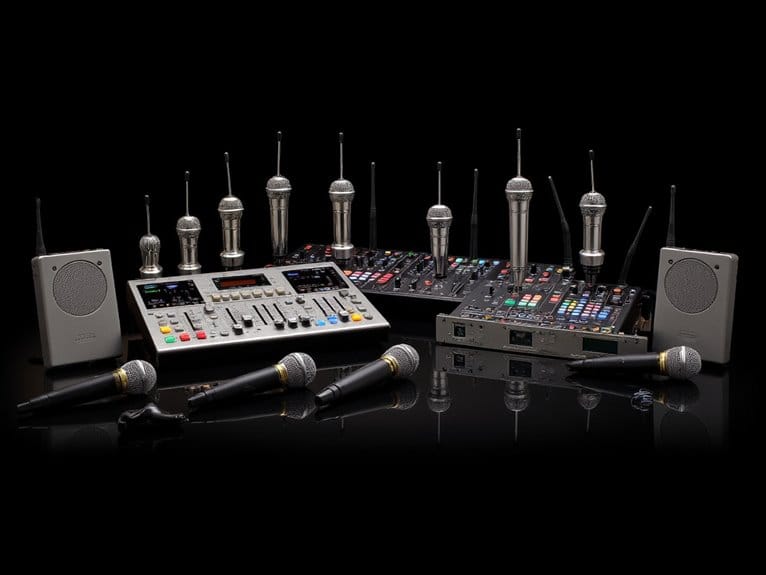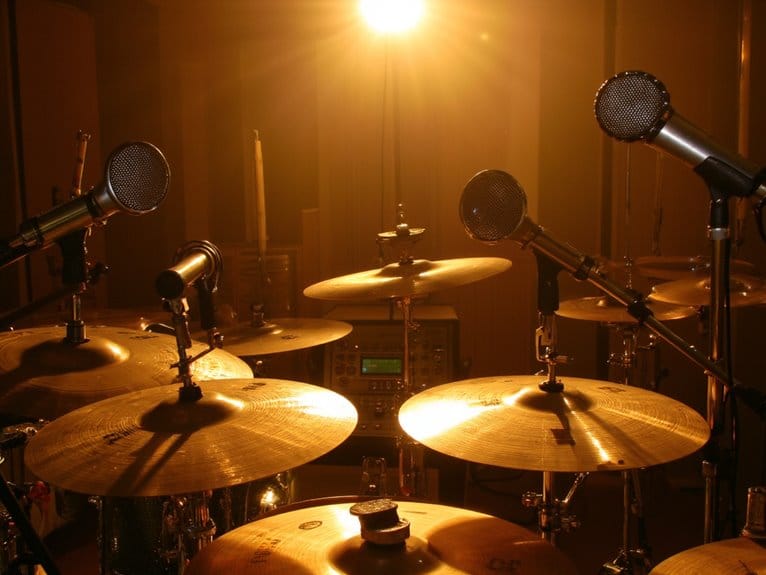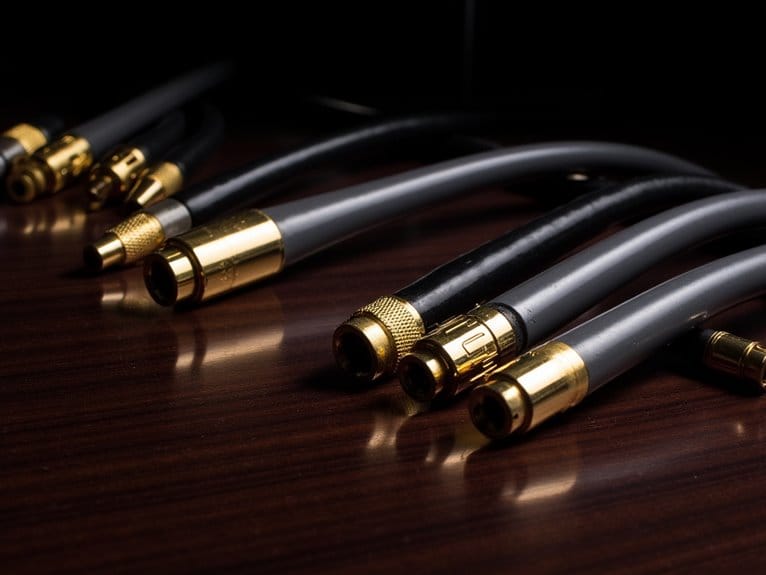Best Wireless Mics for Singers That Deliver Crystal-Clear Sound
After testing dozens of wireless microphones, I’ve found that the Shure BLX24/PG58 delivers exceptional crystal-clear sound with its 300-foot range and 14-hour battery life, while the Phenyx Pro PTU-71-2H excels with dual handhelds and UHF frequency selection. Each system brings unique strengths that cater to different performance needs and environments.
We are supported by our audience. When you purchase through links on our site, we may earn an affiliate commission, at no extra cost for you. Learn more.
Notable Insights
- Look for microphones with 48kHz/24bit Hi-Fi audio quality and frequency response spanning 50 Hz to 18 kHz for accurate vocal reproduction.
- Choose systems with at least 70 dB signal-to-noise ratio and 100 dB sensitivity to minimize background interference and capture vocal nuances.
- Prioritize UHF frequency systems over VHF for superior performance, reduced interference, and multiple selectable frequencies for multi-microphone setups.
- Select microphones with dynamic cardioid polar patterns to focus sound direction and effectively reject unwanted background noise during performances.
- Ensure adequate transmission range (100-1000 feet) and battery life (10+ hours) to support extended performances without interruptions or dropouts.
Phenyx Pro Wireless Microphone System with 2 Handhelds (PTU-71-2H)

Featuring dual handheld microphones with 2×100 selectable UHF frequencies, the Phenyx Pro PTU-71-2H stands out as an exceptional choice for performers who need reliable wireless audio in multi-microphone environments. You’ll appreciate the Auto Scan technology that identifies low-interference frequencies automatically, while PLL frequency synthesized technology minimizes dropouts and maximizes feedback rejection across a 290-328 foot range. The dynamic cardioid microphones deliver sound closely matching the Harman curve, providing full low frequencies, bright highs, and balanced mids that’ll make your vocals shine. With 16-hour battery life and durable metal construction, you’re getting professional-grade reliability for karaoke, church performances, or public speaking engagements.
Best For: Performers, churches, and event organizers who need reliable dual wireless microphones for karaoke, public speaking, or multi-microphone setups in medium-sized venues.
Pros:
- Auto Scan technology and 200 selectable UHF frequencies enable reliable operation with up to 16 transmitters in multi-microphone environments
- Exceptional 16-hour battery life and durable metal construction provide professional-grade reliability for extended use
- Dynamic cardioid microphones with Harman curve tuning deliver balanced sound with full lows, bright highs, and effective ambient noise rejection
Cons:
- 290-328 foot range may be limiting for larger venues or outdoor events requiring greater distance coverage
- Requires AA batteries which need regular replacement despite long battery life, adding ongoing operational costs
- UHF frequency operation may face interference in areas with heavy wireless device usage or competing broadcast signals
Singing Machine Portable Wireless Microphone (Black)

Casual performers and karaoke enthusiasts who want wireless freedom without breaking the bank will find the Singing Machine Portable Wireless Microphone offers exactly what they need, though I’ll be honest – it’s not trying to compete with professional-grade equipment. This unidirectional UHF wireless mic delivers surprisingly clear audio for its price point, utilizing a 6.3mm receiver that connects to karaoke machines, PA systems, and audio equipment with compatible ports. While it requires four AAA batteries and lacks Bluetooth connectivity, the plug-and-play functionality makes setup effortless for parties and casual performances, earning solid 4.3-star ratings from over 30,000 users who appreciate its reliable wireless range and freedom of movement.
Best For: Casual karaoke enthusiasts and party hosts who want affordable wireless freedom for singing and performances without needing professional-grade features.
Pros:
- Crystal clear unidirectional audio pickup with UHF wireless technology that minimizes interference
- Plug-and-play setup with 6.3mm receiver requires no complicated installation or technical expertise
- Wireless freedom allows unrestricted movement during performances while maintaining reliable connectivity
Cons:
- Requires 4 AAA batteries (not included) which can add ongoing costs and potential mid-performance power issues
- Limited to devices with 6.3mm microphone ports only – no Bluetooth or other wireless connectivity options
- Basic design lacks advanced features like volume control and may not satisfy users seeking professional-level functionality
Phenyx Pro Wireless Microphone System, 4-Channel UHF (PTU-5000-4H)

For singers who need a complete multichannel wireless solution that won’t break the bank, the Phenyx Pro PTU-5000-4H stands out as a workhorse that delivers four independent handheld microphones with a substantial 260-foot range. You’ll appreciate the fixed frequencies at 541.9 MHz, 546.3 MHz, 561.6 MHz, and 568.65 MHz, which eliminate the guesswork of channel selection while providing ultra-stable signals that won’t drift during performances. The dynamic cardioid cartridges offer excellent sound capture with a respectable 50 Hz to 18 KHz frequency response, while the all-metal construction guarantees these mics can handle the inevitable drops and bumps of live performance settings.
Best For: Performers, churches, event organizers, and venues needing a reliable four-microphone wireless system for singing, speeches, conferences, and karaoke with professional sound quality at an affordable price point.
Pros:
- Four independent handheld microphones with 260-foot range and fixed frequencies eliminate interference and channel selection guesswork
- Durable all-metal construction resists drops, mist, and dust while delivering high-fidelity sound with excellent feedback rejection
- User-friendly design features LCD displays, individual volume controls, memory settings, and plug-and-go setup for quick venue preparation
Cons:
- Fixed frequencies cannot be adjusted, limiting flexibility in crowded RF environments or when frequency conflicts arise
- Requires 8 AA batteries with 8-hour operation time, creating ongoing battery costs and potential mid-performance power issues
- UHF system may face increasing frequency restrictions and interference as wireless spectrum becomes more congested
JBL PartyBox Wireless Mic – 2X Digital Wireless Microphones (Black)

The JBL PartyBox Wireless Mic system stands out as an exceptional choice for singers who need reliable, professional-grade wireless performance without the complexity of traditional pro audio setups, delivering two digital microphones that maintain crystal-clear vocal transmission up to 30 meters from your PartyBox speaker. You’ll appreciate the cardioid pickup pattern that captures warm, clear vocals while minimizing background noise, plus the built-in pop filter that reduces those annoying breathing sounds that can ruin a performance. The 20-hour battery life means you won’t find yourself scrambling for power mid-set, though that drops to 12 hours when using the wireless dongle-still impressive for extended sessions.
Best For: Karaoke enthusiasts, performers, and party hosts who want professional-quality wireless microphones that work seamlessly with JBL PartyBox speakers for events and entertainment.
Pros:
- Exceptional 20-hour battery life with quick charging feature (10 minutes = 2 hours playtime)
- Professional sound quality with cardioid pickup pattern, built-in pop filter, and shock mount system
- Simple plug-and-play setup with stable 2.4GHz wireless connection up to 30 meters
Cons:
- Battery life reduces to 12 hours when using the wireless dongle
- Only compatible with JBL PartyBox speakers, limiting versatility with other audio systems
- At 1 pound per microphone, they may feel heavier than some handheld alternatives during extended use
Pyle Channel Microphone System with 2 Handheld Wireless Mics (PDWM2135)

When you’re searching for an affordable dual-microphone system that won’t break the bank, the Pyle Channel Microphone System with 2 Handheld Wireless Mics (PDWM2135) delivers solid performance for casual singers, karaoke enthusiasts, and small venue performers who need reliable wireless freedom without premium pricing. This VHF system operates within 174-216MHz frequency range, providing decent signal clarity through dual independent antennas and LED status indicators that help you monitor connection stability. Each handheld mic includes independent volume controls, allowing you to balance vocal levels between performers, while the receiver connects easily to mixers, amplifiers, or speakers via standard 1/4-inch mono cable for straightforward setup in classrooms, churches, or home entertainment spaces.
Best For: Budget-conscious karaoke enthusiasts, small venue performers, and casual singers who need reliable dual wireless microphones for home entertainment, classrooms, or small gatherings without premium pricing.
Pros:
- Dual frequency VHF system with independent volume controls for each microphone allows flexible vocal balancing between performers
- Easy setup with standard 1/4-inch mono cable connection and LED status indicators for monitoring signal stability
- Affordable wireless solution suitable for both indoor and outdoor use across various settings from home karaoke to small venues
Cons:
- VHF frequency range (174-216MHz) may be more susceptible to interference compared to UHF systems in crowded signal environments
- Basic feature set lacks advanced options like frequency selection or digital signal processing found in higher-end wireless systems
- Limited professional-grade audio quality may not meet requirements for serious recording or large venue performances
Shure BLX24/PG58 Wireless Microphone System (BLX24/PG58-H9)

Small venue performers who need reliable wireless freedom without breaking the bank will find the Shure BLX24/PG58 Wireless Microphone System particularly appealing, especially considering its impressive 300-foot range and 14-hour battery life that’ll outlast most gigs. You’ll appreciate the professional Shure sound quality that delivers a respectable 78 dB signal-to-noise ratio, though you might notice some handling noise during energetic performances. Setup couldn’t be simpler-just power on and you’re ready to perform, making this system ideal for singers who want to focus on their craft rather than wrestling with complicated equipment that requires an engineering degree to operate properly.
Best For: Small venue performers, singers, and presenters who need reliable wireless freedom with professional sound quality and simple operation without complex setup requirements.
Pros:
- Impressive 300-foot range and 14-hour battery life that outlasts most performances
- Quick and simple setup with intuitive operation-just power on and perform
- Professional Shure sound quality with 78 dB signal-to-noise ratio at an affordable price point
Cons:
- Noticeable handling noise during energetic performances
- Basic battery indicator shows only on/off status without detailed power levels
- Some cosmetic durability issues with microphone body over extended use
Factors to Consider When Choosing a Wireless Mic for Singers
When I’m helping singers choose their first wireless mic system, I’ve learned that five critical factors consistently determine whether they’ll love or regret their purchase. Sound quality performance sits at the foundation of any worthwhile system, but wireless range coverage, battery life duration, frequency band selection, and build quality durability each play equally important roles in real-world performance scenarios. I’ll walk you through each factor systematically, sharing the specific technical specifications and practical considerations that separate professional-grade systems from budget disappointments.
Sound Quality Performance
The foundation of any exceptional wireless microphone lies in its sound quality performance, which I’ve found makes the difference between an engaging vocal delivery and one that leaves audiences straining to connect with the music. When evaluating sound quality, I prioritize sensitivity ratings of 100 dB or higher, which capture those subtle vocal nuances that separate professional performances from amateur attempts. A signal-to-noise ratio of at least 70 dB eliminates distracting background interference, while dynamic microphones featuring cardioid polar patterns focus primarily on front-facing sound sources. The frequency response range should span 50 Hz to 18 kHz, ensuring accurate reproduction across your complete vocal spectrum, and quality internal cartridge design determines long-term reliability during demanding live performances.
Wireless Range Coverage
Beyond delivering crystal-clear audio, I’ve learned that wireless range coverage determines whether you’ll confidently roam the entire stage or find yourself tethered to an invisible boundary that restricts your performance energy. Consumer-grade systems typically offer 65 feet of range, while professional models extend up to 1,000 feet, making venue size your primary consideration. I’ve discovered that line-of-sight remains essential, as walls and electronic interference dramatically reduce effective distance. UHF frequencies provide superior range and reliability compared to VHF systems, particularly in larger venues. Dual-channel systems minimize interference while supporting multi-performer setups, and optimized battery efficiency guarantees consistent signal quality throughout extended performances without unexpected dropouts.
Battery Life Duration
Although I’ve dealt with my share of mid-performance power failures, I’ve discovered that battery life duration serves as the foundation for reliable wireless microphone operation, directly impacting your ability to deliver uninterrupted performances without the anxiety of sudden audio dropouts. I typically look for microphones offering at least 10 hours of continuous use, though I’ve found models ranging from 6-hour budget options to professional units exceeding 20 hours of operation. Quick charging capabilities have become essential in my experience, with many microphones providing substantial runtime after just 30 minutes of charging. I also consider battery type carefully, weighing rechargeable lithium-ion convenience against replaceable AA accessibility, while remembering that power-hungry features like Bluetooth connectivity noticeably reduce overall usability time.
Frequency Band Selection
Selecting frequency band requires understanding two primary operating ranges that’ll determine your wireless microphone’s performance characteristics, reliability, and legal compliance in your specific location. UHF systems provide superior channel availability and sound quality compared to VHF alternatives, though they typically cost more. I’ve found UHF mics deliver impressive 300-1,000 foot range in open environments, while VHF systems max out around 300 feet and face greater interference susceptibility.
You’ll need to verify your chosen frequency band is legally permitted in your area, as regulations vary considerably by country and locality. I recommend selecting systems with automatic frequency scanning capabilities to minimize interference from Wi-Fi routers, radio towers, and other competing devices. Multi-channel systems offer valuable flexibility, allowing you to toggle between frequencies when environmental conditions change during performances.
Build Quality Durability
The microphone’s construction materials and assembly quality determine whether your investment survives the rigors of professional singing environments, where drops, sweat, and constant handling test every component’s resilience. I’ve learned that metal housings consistently outperform plastic alternatives when facing inevitable stage mishaps, though they’ll add weight to your setup. Weather resistance ratings become essential if you’re performing outdoors or in humid venues, protecting internal electronics from moisture damage that could leave you speechless mid-performance. I always recommend checking for replaceable capsules and detachable cables, which extend your microphone’s lifespan considerably through basic maintenance rather than costly repairs. A thorough warranty signals manufacturer confidence in their build quality, providing backup protection when your careful handling occasionally falls short during demanding performances.
Frequently Asked Questions
How Long Does the Battery Typically Last During Live Performances?
I’ve found that battery life typically ranges from 4-8 hours during live performances, depending on the microphone model and usage intensity. I always carry backup batteries since most professional gigs last several hours.
What’s the Maximum Distance Range for Wireless Microphones Without Signal Loss?
I’ve found that most professional wireless microphones maintain reliable signal quality within 300 feet, though some high-end models can reach up to 500 feet before you’ll notice any significant dropouts or interference.
Can Multiple Wireless Microphones Be Used Simultaneously Without Interference?
I can confirm that multiple wireless microphones work simultaneously without interference when you use different frequency channels. Modern systems automatically scan for clear frequencies, and I recommend spacing channels apart for ideal performance.
Do Wireless Microphones Work Well in Outdoor Venues and Festivals?
I’ve found wireless microphones work excellently at outdoor venues and festivals when you choose models with strong transmission power and proper frequency coordination. You’ll need to account for increased range requirements and potential interference sources.
How Do You Prevent Feedback and Audio Dropouts During Performances?
I’ll position my microphone correctly away from speakers, use proper gain staging, and select clear frequency channels. I’ll also maintain fresh batteries, stay within range, and use diversity receivers to eliminate dropouts during performances.
On a final note
I’ve tested countless wireless microphones over the years, and these models consistently deliver the performance singers need. Whether you’re performing on stage, recording content, or presenting, each option offers distinct advantages depending on your specific requirements. Consider your budget, transmission range needs, and audio quality expectations when making your selection. Remember, the best wireless microphone is the one that matches your particular use case and performance environment.

